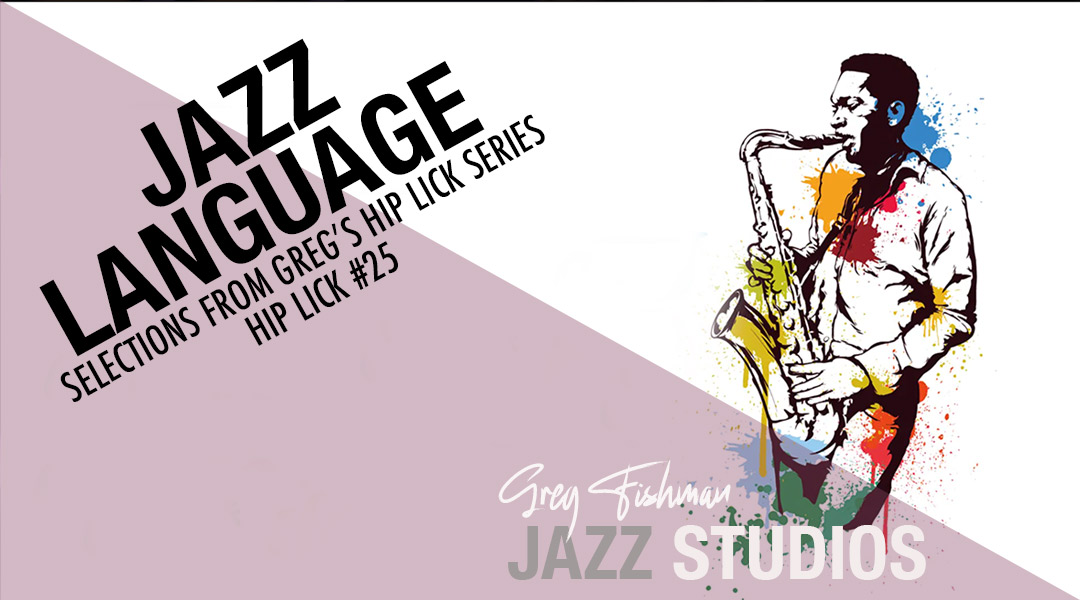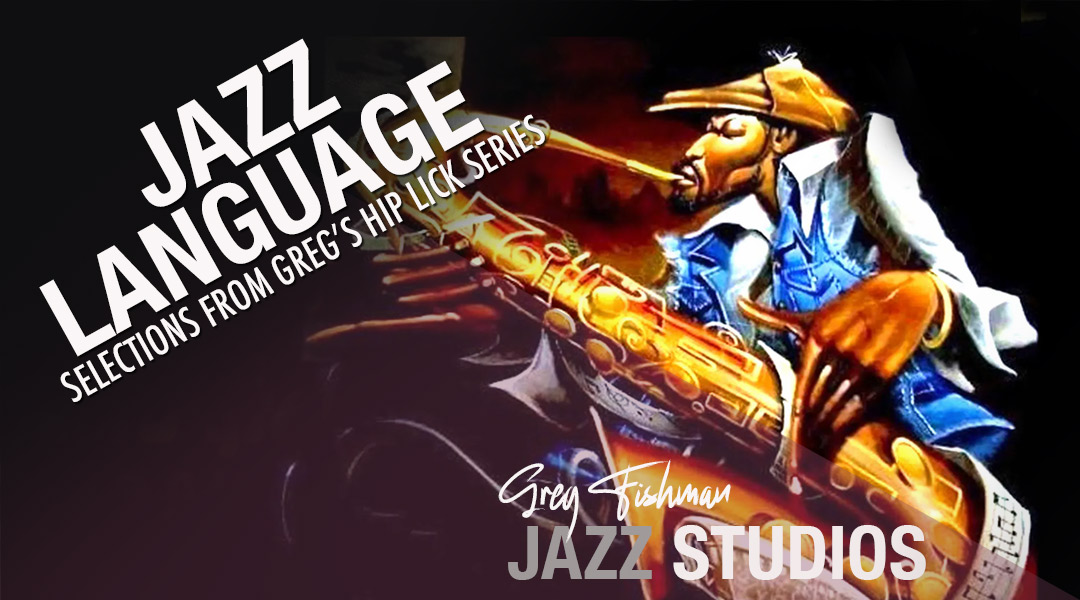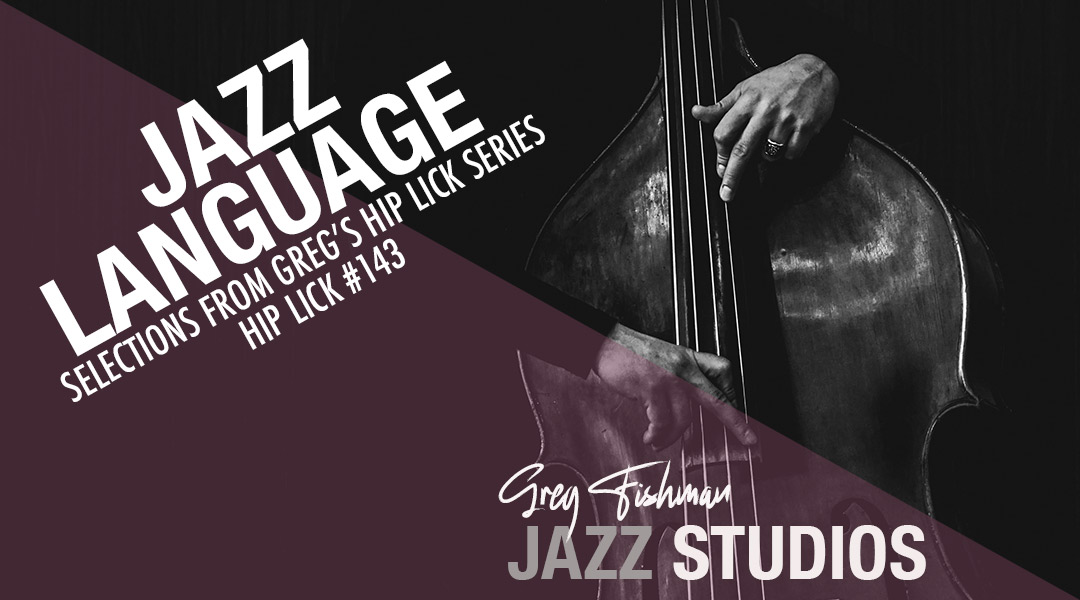Exploring Hip Lick #25
Exploring Hip Lick #37
Exploring Hip Lick #37
Exploring Hip Lick #49
Exploring Hip Lick #49
Exploring Hip Lick #143
Exploring Hip Lick #143
1 Lick in 12 Keys vs. 12 Licks in 1 Key
1 Lick in 12 Keys vs. 12 Licks in 1 Key
Exploring Hip Lick #157
Exploring Hip Lick #157
Chicago Ave (Satin Doll) – Melodic Embellishment
Chicago Ave (Satin Doll) – Melodic Embellishment
Phil Woods Turnaround Lick
Phil Woods Turnaround Lick
The Chromatic Triplet Trick
Chromatic Triplet Trick
The “Dooden” Tongue
The “Dooden” Tongue
Exploring Hip Lick #25
Exploring Hip Lick #25
Exploring Hip Lick #37
Exploring Hip Lick #37
Exploring Hip Lick #49
Exploring Hip Lick #49
Exploring Hip Lick #143
Exploring Hip Lick #143
1 Lick in 12 Keys vs. 12 Licks in 1 Key
1 Lick in 12 Keys vs. 12 Licks in 1 Key
Exploring Hip Lick #157
Exploring Hip Lick #157
Chicago Ave (Satin Doll) – Melodic Embellishment
Chicago Ave (Satin Doll) – Melodic Embellishment
Phil Woods Turnaround Lick
Phil Woods Turnaround Lick
The Chromatic Triplet Trick
Chromatic Triplet Trick
The “Dooden” Tongue
The “Dooden” Tongue
Module 14
In this video, I share my system for practicing the chromatic scale the full range of the saxophone. This is a fun one, and it will give you very smooth technique, as long as you have the patience to follow step by step, adding one note at a time, as I describe in the lesson. INTERMEDIATE & ADVANCED LEVEL.
In this video lesson, I show you how to take the diminished scale to the next level, playing it in 3rds over a V7b9 chord. This has a very cool, edgy sound which always reminds me of one of my old teachers, the great Joe Henderson. Although this may sound complex, I really break it down into simple steps in the video. The PDF lesson notes provide a very thorough practice guide for the lesson. INTERMEDIATE/ADVANCED LEVEL
In this video lesson, I work with lick #25 from Hip Licks for Saxophone. This is a very cool major 7th lick. I play the lick and then break it down into separate parts, making it very easy to understand. I also share a fun analogy about the importance of developing your musical memory, so that you can compare two musical phrases with very slight differences between the two versions. I also play the lick in twelve keys, descending in half-steps. At the end of the video, I share some advanced concepts for working with the lick. PDF dowload materials include detailed notes and the lick written in all twelve keys. INTERMEDIATE/ADVANCED LEVEL
Many group members have asked me to create a video in which I demonstrate some of my practice techniques for working with the book, Tasting Harmony. In this video, I explain the concept of the book and demonstrate many different ways of working with the play-along tracks. The extras with this video include several pages from the book, some of the exercises from the video, plus the mp3 tracks. ALL LEVELS.
Greg shows how to keep your mind focused and sharp even when you’re away from the horn. This music theory game involves thinking of the note “A” as different degrees of major scales.
Module 34
LESSON 1: Four Directions – Thinking Locally and Globally
I often mention practicing in four directions for gaining mastery over your scales, chords and intervals. In this video lesson, I explore and explain the four directions. I describe the difference between thinking “locally” and “globally” when playing a sequential pattern.
LESSON 2: Finding the hidden Diminished and Augmented Chords in the Chromatic Scale
In this video lesson, I show you how to use the chromatic scale to diminished chords and augmented chords. Although I demonstrate these same chords in different video lessons (playing all of them on piano), this is an alternative approach, designed to help players that find it a real challenge learning the traditional way.
LESSON 3: Exploring Hip Lick #37
In this video lesson, I work with lick #37 from the book “Hip Licks for Saxophone Volume 1.” This is a two-measure C7 lick that uses part of the bebop scale, contrary motion, sequence and a diatonic enclosure.
In this video lesson, I share my technique for this popular special effect tonguing used by Getz, Bird, Pres and many of the top players from the Swing/Bop era. This one is intentionally an “all-ear” lesson, so there are no practice notes on this one.
LESSON 5: Listening Recommendation: Clifford Brown • Max Roach
This amazing 1958 album has so many classics…Daahoud, Joy Spring, Jordu, Parisian Thoroughfare…all on the same album. The beauty and symmetry of Clifford’s playing throughout this album is breathtaking.
Module 29
In this video lesson, I share some essential voice-leading strategies which will transform your chord arpeggios, making them sound smooth and professional.
In this video lesson, I share some essential voice-leading strategies which will transform your chord arpeggios, making them sound smooth and professional.
Hip Lick #49 is based on Cmi7. It’s a two-measure lick that outlines the primary notes of the chord (7-5-3-1) while also including some popular bebop elements, such as the opening triplet rhythm on the first beat.
Many students come to me with the same issue…they want to have a smooth sound when playing eighth-note lines, but no matter how slowly they practice, they still have a “choppy” sound. This is a tricky problem to correct because it has several causes.
In this video, I discuss one of my all-time favorite albums, Marcos Valle’s “Samba ’68.” It’s deceptive because it sounds so light and fluffy and simple. Actually, it’s incredibly deep, sophisticated writing with some of the catchiest melodies I’ve ever heard.
Module 11
In this video, I’ll take you through my system for practcing the minor 7th intervals in all four directions. Great for ear training, breathing and control of the horn. INTERMEDIATE & ADVANCED LEVEL.
In this video, we’ll work with Hip Licks #143 (from the book Hip Licks for Saxophone, Volume 1). This is a dminished lick which brings out the sound of some of the most powerful notes in the the chord; the major seventh and the flatted thirteenth. Includes harmonic analysis of the lick as well as a performance of the lick in 12 keys in the cycle. ADVANCED LEVEL.
In this video lesson, we’ll explore the etude “Rush Street” from my book, Jazz Saxophone Etudes, Volume 1. This is based on chords similar to “Satin Doll.” Lot’s a great tips in this video, including strategies for simplifying complicated technical passages by changing triplets to eighth notes. There is also some discussion of use of the bis key, side key and 1&1 for Bb. Also includes some demonstration of lower neighboring tones and use of sequence. INTERMEDIATE & ADVANCED LEVEL.
In this video lesson, we’ll explore the etude “Rush Street” from my book, Jazz Saxophone Etudes, Volume 1. This is based on chords similar to “Satin Doll.” Lot’s a great tips in this video, including strategies for simplifying complicated technical passages, some discussion of use of the bis key, and use of sequence. Also includes discussion of voiceleading. INTERMEDIATE & ADVANCED LEVEL.
Greg shows how to keep your mind focused and sharp even when you’re away from the horn. This music theory game involves thinking of the note “F#” as different degrees of major scales. While the note “Gb” also can be used in some scales, “F#” is a better choice for this music theory game, because it easily fits with all of the standard key signatures of the major scale system.
Module 12
Two Great Approaches to Fluency in All Keys – In this video lesson, I’ll share a practice concept which has been great for the development of my playing fluently in all twelve keys. Many are familiar with what I call the “1 in 12 approach.” With this approach to practicing in twelve keys, you take one lick, pattern or song, and play it in 12 keys. However, the “12 in 1 approach” is the reverse…You take twelve different licks and put them all into just one key. This gives you a LOT of material under your fingers in one particular key, and it really improves your hearing in a particular key center. Both approaches are vital, but this 12 in 1 approach is new for most players. Give it a try! I’ve included PDF’s with the 12 in 1 approach for all keys for the first 12 licks of Hip Licks. However, do try them by ear for the best results! INTERMEDIATE & ADVANCED LEVEL.
In this video lesson, I’ll show you how to apply the diminished scale over the V7 chord in a ii-7/V7/Imaj7. This is a great video to watch if you’ve always wondered just how to implement the diminished scale in a moving phrase. First, I’ll play the idea diatonically, using just the notes of the major key. Next, I’ll explain and demonstrate, how to use the notes of the diminished scale in the phrase. In this video, I teach the lesson while playing the examples on the VIBRAPHONE. The vibraphone is great for this type of training, because it’s visual, making it easy to see what I’m doing as I give harmonic analysis. The vibes are also great for working on your saxophone intonation. When you play along with the vibes in the video, you can easily hear if you’re out of tune, because the sound of the vibes is such a pure tone. In addition, the vibes, allow you to hear multiple notes at once, which is great for hearing in harmonic context. PDF NOTES include transposed examples for all C, Bb and Eb instruments. INTERMEDIATE & ADVANCED LEVEL.
In this video lesson, I explore four different fingerings for middle Eb on the saxophone. The old-school players like Dexter, Stitt, Getz, Coltrane, Etc., liked to customize the timbre of their notes. Developing the ability to customize the weight and timbre of your notes will add a pro-level touch of detail to everything you play. If you’re not taking advantage of these four middle Eb options every time you play your horn, you’ve been missing out. Join in the fun with these cool sounds! INTERMEDIATE LEVEL.
In this video lesson, I’ll show you how to apply the major 7th interval to one of my favorite harmonic settings, using the notes of the interval as the 3rd and #9th on a dominant seventh chord. While this is not technically difficult to play, harmonically speaking, for some players, it will take the ear a little bit of time to get used to the sound. In the video, I demonstrate the sound several different ways, so that it’s easy for your ear to hear the interval in this new setting. I first heard Sonny Stitt use this sound when I was learning to play, and have used it ever since. This sound will add a very nice harmonic edge to your playing. INTERMEDIATE & ADVANCED LEVEL.
Greg shows how to keep your mind focused and sharp even when you’re away from the horn. This music theory game involves thinking of the note “B” as different degrees of major scales.
Module 03
In this video, I demonstrate the enclosure, one of the most common elements of the bebop language. An enclosure consists of a targeted note preceded by upper and lower neighboring tones. Includes several practice strategies for working with the enclosures.
In this video, I break down Hip Lick #157 into component parts and show you how the lick is built. Getz, Stitt, Coltrane, Rollins…they all use this fantastic device, which provides great harmonic color through voice-leading on the minor chord in a ii / V or ii / V / I.
Ideas and exercises for practicing, and getting the most out of this original jazz Etude with your ALTO sax.
Ideas and exercises for practicing, and getting the most out of this original jazz Etude with your TENOR sax.
In this lesson, I’ll show you how to think of one note in four different locations within a major 7th chord. For example, C = Root of Cmaj7, but C = the 3rd of Abmaj7, C = the 5th of Fmaj7, and C = the 7th of Db maj7. The importance of enharmonic notes is also discussed in the video.
Module 33
In this two-part video lesson, I take you through the essentials of voice leading, introducing you to the concept from the keyboard, making it very easy for your ear to follow along.
This video lesson continues where part 1 left off, showing you how to take the individual voice leading lines and combine them to form melodies.
In this video lesson, I demonstrate the concept of melodic embellishment, using my composition “Chicago Avenue” from “Jazz Phrasing for Saxophone, Volume 1.” This is a medium tempo swing piece based on chords similar to “Satin Doll.” In the lesson, I’ll show you how I embellish the original melody of Chicago Avenue by connecting new notes to the original melody.
Recorded in 1958, this masterpiece by the Hi-Lo’s is one of my favorite vocal jazz albums. The Hi-Lo’s, comprised of four male vocalists: Clark Burroughs, Gene Puerling, Bob Strasen and Bob Morse.
Module 28
In this video lesson, I share some of my techniques for getting the sounds in your head to come out on your horn.
In this video lesson, we’ll explore one of my favorite harmonic settings a minor second interval, acting as the 3rd / 9th / 3rd of a minor seventh chord. This has a very Getzian kind of sound…smooth and melodic. Includes page 22 from “Intervals in Action,” plus detailed PDF practice guide for C, Bb and Eb instruments. INTERMEDIATE LEVEL
In this video lesson, I explore what I call the “Phil Woods” turnaround lick. It uses two voice-leading notes to create a beautifully balanced, melodic line of eighth-notes.
Part of the bebop tradition involves the usage of both upper extensions and implied harmony. The mixing of the minor triad with a diminished seventh chord adds a strong harmonic boost to any minor passage.
In this video, I discuss one of my all-time favorite albums, Charlie Parker’s masterpiece album, “Charlie Parker with Strings.” The album features popular standards from the Great American Songbook, arranged for the strings-plus-rhythm section. Parker at his most eloquent. One of my all-time favorites.
Module 26
In this four-part lesson, I’ll show you my process for transcribing solos. This lesson is really dense and packed with tips and techniques for transcribing. For the demonstration of how to transcribe, I’ve selected the first chorus of a Sonny Stitt blues called “Down With It.”
In the old days, none of this technology existed, and I would transcribe from a cassette player, and then directly from a CD player (which still actually works pretty well). The main thing to remember is to be very patient while transcribing and to have lots of patience with yourself and with the process.
In this video lesson, I’ll show you a very cool and useful pattern based on a triplet rhythm, using the chromatic scale. This pattern works incredibly well to nail the changes of a minor ii / V / i chord progression.
In this video, I discuss one of my all-time favorite albums, the Kenny Burrell & John Coltrane album on the Prestige label. The album features lots of catchy bebop-oriented tunes plus one ballad with Coltrane duet with Kenny Burrell on guitar. Great album!










